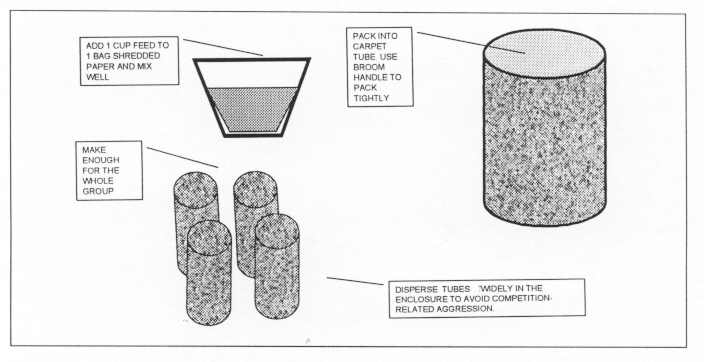Sue Howell1, Jo Fritz1, Ann Silvers1,2
1Primate Foundation of Arizona
2Institute for Human Origins/Arizona State University
A special thank you to Christine Maller, a caregiver at Zoo Atlanta, for designing this wonderful enrichment. She posted it to the Primate Enrichment forum (October, 1998) for use with monkeys and orangutans. In November, 1998, we adapted it for chimpanzees. We have found it also works well for adult captive chimpanzees. Thank you Christine!
The goal of all enrichment devices is to provide occupation and to increase or promote natural behavior. This particular device has the goal of increasing foraging and manipulatory behavior and adds variety to our existing enrichment program.
The device consists of food treats (hard-shelled nuts, popcorn, pretzels, and chicken scratch) mixed with shredded paper and stuffed into a 4 foot long section of a cardboard tube. The tubes are obtained from a carpet store at no cost. They are approximately 4" to 6" in diameter, 1/4" thick, and 12' to 18' long. The tubes are cut into 4' lengths, thus each cardboard carpet tube makes three of four devices. The empty tubes are stuffed with shredded office paper and forage materials by volunteers. A broom is used to pack the material very tight making retrieval of forage items more difficult (Figure 1). The end result is a "party popper" that contains the treats mixed well with shredded paper. Chimpanzees occupation includes: manipulating the tube, extracting the paper (which may end in a nest), foraging for treats mixed in the paper, making cardboard wedges, and play with the empty tubes.
Our volunteer staff found that each tube took 3 minutes to fill. The wider the tube, the less time it took to fill it. Approximately four brown paper grocery bags of shredded paper will fill 10 tubes. Each tube is filled with no more than 1 cup of forage material. We used a half cup of chicken scratch, a handful of air-popped popcorn, and 4-5 whole pecans in the shell. Caregivers gave the first tubes to small groups of chimpanzees and collected ad lib observations (thank you PFA caregivers!). The first subject, an adult female, spent 18 minutes extracting all of the forage and paper materials, she then made a nest with the shredded paper from the tube and a wage from some of the cardboard. The second subject, also an adult female, totally ignored the device. It took her several hours to figure out there were "goodies" inside. When we came back the next morning, however, a crumpled empty tube was all that was left. Across the period of a week, we tried the device on adult males, adult females, adolescence, and juveniles. Competition-related aggression in social groups was eliminated by providing a device to each animal in the social group. Young animals (2 to 4 years old) had more difficulty in removing the paper and one adult male ignored the treats but made a nest with the paper.

Reprinted with permission of the Editor of The Newsletter.